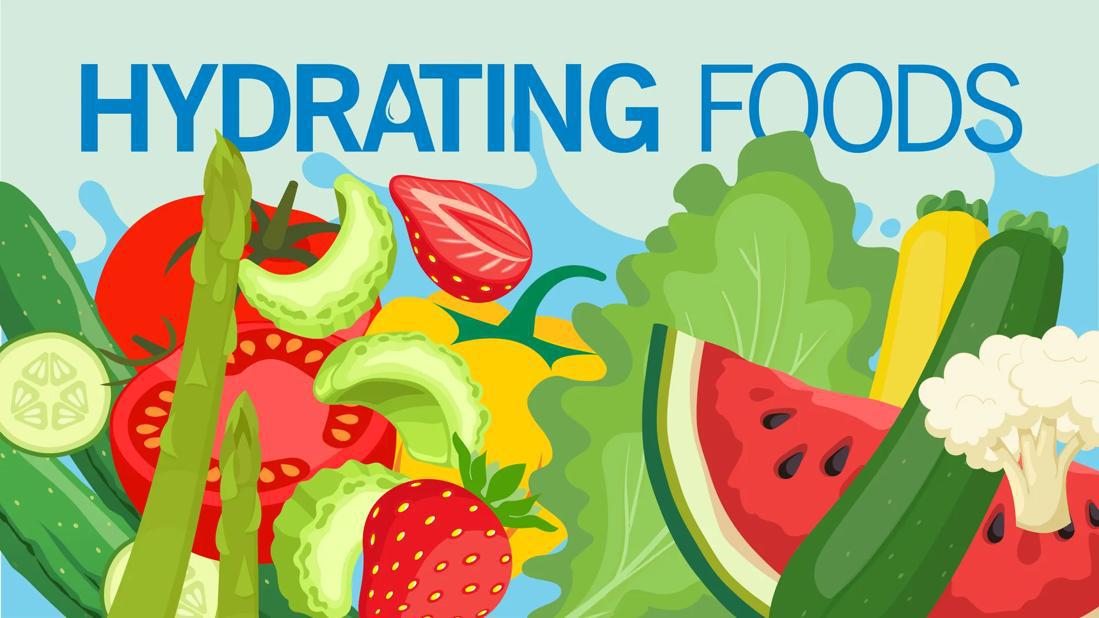Soak It In: 10 Foods To Help You Stay Hydrated
Cucumbers, celery and (of course) watermelon are among foods with high water content

A glass of water isn’t the only way to hydrate. You can also do it with a fork.
About 20% of the fluid you take daily comes from food, as almost everything on your plate contains some water. But certain menu items have enough H2O to be considered hydrating foods.
Let’s dive into foods with high water content with registered dietitian Julia Zumpano, RD, LD.
Are you hydrating enough?
Your body needs water to function. Even mild dehydration — just being a pint or two low — can lead to problems. Confusion, crankiness and dizziness might set in. Muscles could cramp up. A headache may start.
Dehydration can lead to serious health issues, too. It’s estimated that 1% to 3% of all hospital admissions in the United States can be linked to dehydration.
Avoiding dehydration comes down to taking in enough water through drinking and eating. The Academy of Nutrition and Dietetics recommends a daily fluid intake from both liquids and food of:
- 124 ounces/15.5 cups (3.7 liters) for men
- 92 ounces/11.5 cups (2.7 liters) for women
But those needs could increase day to day, depending on how much you’re sweating (and losing water). Physical activity, warmer temperatures or illness can all work to drain your body of fluid, too.
“Keeping your body adequately hydrated is essential for several reasons, including improved brain function, getting nutrients to cells, waste removal and joint lubrication,” says Zumpano.“Hydration also helps improve physical performance and regulates body temperature.”
Foods high in water content
So, what juicy foods can help keep you hydrated in addition to what you drink? Here are 10 grocery store items (all from the produce section) that offer a healthy splash of water.
1. Cucumbers
Few options are as cool as a cucumber when it comes to picking hydrating food. This green garden gourd is more than 96% water, making it a giant when it comes to delivering fluid to your body.
Cucumbers also deliver nutritionally, emphasizes Zumpano. They’re loaded with body-boosting antioxidants and essential nutrients like vitamin K, which works to keep your bones strong as you age.
They’re even beneficial as a skin care tool. Placing chilled cucumber slices over your eyelids can reduce puffiness around your eyes while hydrating your skin.
2. Celery
Chomping on celery offers both a satisfying crunch and a healthy dose of fluid, as the fibrous veggie is about 95% water. (Fun fact: Celery offers a bigger crunch when it’s more water-logged.)
It’s swimming in vitamins and minerals, too, including electrolytes like magnesium and potassium.
3. Lettuce
Leafy greens? It’s more like watery greens, as just about any type of lettuce you toss in a salad contains liquid goodness. Iceberg lettuce floats to the top of the list with 96% water content. More nutrient-dense lettuce varieties, such as romaine and butterhead, are a few drops behind.
Green leafy vegetables such as kale and spinach are also at least 90% water.
“Any of those options can be a good hydrating base for your summer salad,” says Zumpano.
4. Tomatoes
Whether you pronounce it toh-may-toh or toh-mah-toh, know that you’re talking about a piece of produce that’s about 95% water. One cup of chopped tomatoes offers nearly a juice glass worth of water.
Tomatoes offer a ton of nutritional benefits, too, but let’s highlight this: The antioxidant that gives a tomato its red color can help reduce your heart disease risk.
5. Zucchini
Water runs in the family line for zucchini, which belong to the same plant family as cucumbers. This versatile summer squash is almost 95% water. (Hmmm … maybe it should be called a summer squish?)
Better yet, zucchini boasts an impressive nutritional resume. Healthy perks include antioxidants like beta-carotene, lutein and zeaxanthin, which are especially important for eye health.
6. Watermelon
No surprise that water is in watermelon, right? It’s in the name, after all. The refreshing fruit is roughly 92% water, which explains why biting into a slice often sends a stream of juice down your chin. (So worth the mess, though!)
Watermelon is also chock-full of nutrients to help your immune system, eyes, skin, gut health and more, says Zumpano.
7. Cauliflower
Nobody looks at cauliflower and thinks, “Gosh, that’s a mighty juicy veggie.” But the reality is that 92% of its weight comes from water.
The creamy white florets from the cruciferous vegetable are also packed with vitamin C, vitamin K and other key vitamins and minerals. There’s even evidence that eating cauliflower may protect against cancer.
8. Bell peppers
Bell peppers answer the … well, bell when it comes to providing hydrational value. A bell pepper is typically more than 92% water, no matter the color, and they’re chock-full of vitamins and minerals.
9. Asparagus
An asparagus spear is about 92% water. That information could be helpful after a night on the town, too. The reason? That extra fluid, plus a pair of enzymes in asparagus, may help you better recover from the dehydrating effects of a hangover.
10. Strawberries
Strawberries earn their juicy reputation with a water content that hovers above 90%.
Your odds of remembering that fact increase if you eat this sweet treat, too, as it’s a rich source of compounds called flavonoids that are associated with improved cognitive function. One study found that eating flavonoid-rich berries delayed cognitive aging by up to two-and-a-half years.